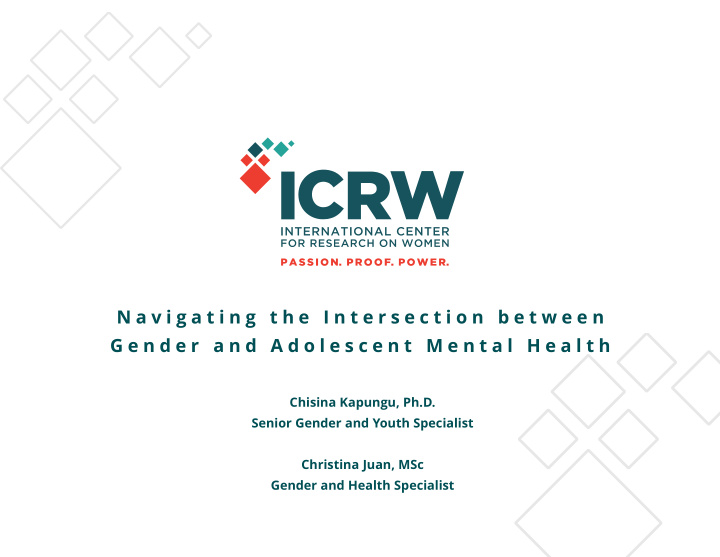



N a v i g a t i n g t h e I n t e r s e c t i o n b e t w e e n G e n d e r a n d A d o l e s c e n t M e n t a l H e a l t h Chisina Kapungu, Ph.D. Senior Gender and Youth Specialist Christina Juan, MSc Gender and Health Specialist
O b j e c t i v e s To understand the relationship between gender and adolescent mental health To discuss priorities for research and action to improve adolescent mental health by focusing on gender
S e x o r G e n d e r ? Sex Gender Biologically determined Social construct Chromosomes: Male Behaviors, roles and and Female expectations of society Internal and external Femininity and organs Masculinity
G e n d e r E x i s t s A l o n g a C o n t i n u u m Biological Sex (anatomy, chromosomes, hormones) Male Intersex Female Gender Identity (psychological sense of self) Man Third Gender Woman Gender Expression (communication of gender) Masculine Androgynous Feminine
G e n d e r & M e n t a l H e a l t h “Gender is a critical determinant of mental health and mental illness. It determines the differential power and control men and women have over the socioeconomic determinants of their mental health and lives, their social position, status and treatment in society, and their susceptibility and exposure to specific mental health risks .” (WHO, 2014) Stephanie Sinclair, National Geographic
Social Inequality Adolescent Mental Health in LMICs Physical Nutrition Health
G e n d e r & M e n t a l H e a l t h Gender role differentiation Gender intensification Gender role conflict Stephanie Sinclair, National Geographic
D e a t h s i n 1 5 - 1 9 y e a r o l d s ( 1 9 9 0 , 2 0 0 5 , 2 0 1 3 ) Male Female
V i o l e n c e A g a i n s t C h i l d r e n S u r v e y D i s t r i b u t i o n ( % ) o f s u i c i d a l t h o u g h t s i n a d o l e s c e n t s a g e s 1 3 - 1 9 VACS* Country Females Males Difference (Females- (survey year) Males) Cambodia (2013) 5.41% 1.28% 4.13% Haiti (2012) 23.41% 6.27% 17.14% Kenya (2010) 13.44% 6.29% 7.15% Malawi (2013) 4.43% 2.50% 1.93% Tanzania (2009) 7.30% 5.51% 1.79% Swaziland (2007)* 14.00% N/A N/A Average 11.33% 4.37% 6.43% % = adjusted; accounted for complex survey design within each dataset * = Violence Against Children Survey ** = females surveyed only
V i o l e n c e A g a i n s t C h i l d r e n S u r v e y
O u r P r e l i m i n a r y H a i t i A n a l y s e s Adolescent girls have a higher odds of experiencing mental distress in the past 30 days: if they’ve ever worked are wealthier or have experienced multiple forms of violence (sexual, physical, emotional) in the last 12 months. Strong evidence of association between: suicidal ideation mental distress risk-taking behaviors (e.g. ever having sex) having experienced multiple different forms of violence in the last 12 months Stephanie Sinclair, National Geographic
O p p o r t u n i t i e s f o r A c t i o n Research Program Systematic Review Integrate gender in adolescent friendly Programmatic Review services Secondary data analyses Adapt materials and Scale development curriculum Qualitative and Train frontline professionals on gender- Quantitative Research specific risk factors Pilot test interventions
O p p o r t u n i t i e s f o r A c t i o n Donor Policy Invest in rigorous Strengthen the health evaluations sector’s response Fund the development, Policy review and change implementation and Action plans scaling up of effective National guidelines, strategies standards, and supporting tools
M o r e t o L i f e To g e t h e r I n t e r n a t i o n a l I n t e r n a t i o n a l f o r G i r l s M e d i c a l C o r p s
Q u e s t i o n s Questions?
Recommend
More recommend